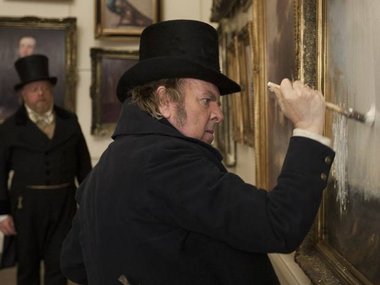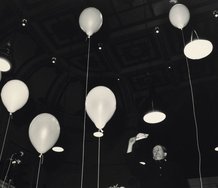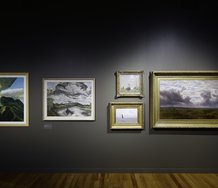Peter Ireland – 7 February, 2015
Much has been made in the film's publicity about the actor playing Turner, Timothy Spall, having studied painting practically for two years before taking on the role. After viewing him in action it's not unreasonable to wonder that if he'd studied for four years would he have been any less of a duffer in handling a brush? In the Leigh scenario Spall's quivering lower lip, a channel for gathering spittle, seems to have a greater impact on the act of painting than anything his hand may be doing.
Mr Turner, a 2014 film by Mike Leigh, starring Timothy Spall as the artist, in general release.
Why do people make films about artists? Mostly for two reasons: firstly because the art itself seems significant enough in some way to warrant attention; secondly, the artist is “a character” in the Romantic artist mould - a social rebel, unconventional, artistically innovative and, hopefully, someone whose genius went unrecognised in his lifetime. Making films about inert art works is a challenge; “inert” and “movie” not being a very promising combination. But making a film about “a character” is a different kettle of turps, an opportunity to whip up an expressionist melange of colour and texture, providing entertainment as well as subtly reinforcing the tired notion of the artist as Romantic rebel and outsider.
A notable film about just the art was Australian Paul Cox’s 1987 Vincent: the life and death of Vincent van Gogh. Apart from a few reconstructed scenes from the artist’s life there were really no actors as such, the film being threaded together by the works themselves and the locations which inspired them, with a voice-over by John Hurt reading from the letters exchanged by the artist and his brother Theo. The hapless Vincent may have failed miserably, but he really wanted to “fit in” and contribute humbly something of lasting value to his society, keenly aware of the poor and the oppressed. The film was austere, effecting and unforgettable.
A more conventional film in terms of plot and characters was Peter Watkins’ 1974 movie about the art and life of Edvard Munch, called, starkly, Edvard Munch. Originally made for television in three, hour-long parts, it was later released as a proper film, with little of the original material edited out. Ingmar Bergman, no less, described it as “a work of genius”. It depicted the formal, painterly struggles of an earnest, very bourgeois Norwegian artist who dressed soberly and minded his social manners.
Watkins as writer and director found contemporary Norwegians who, spookily accurately, resembled the subjects of Munch’s portraits, and frequently in the film their heads, singly, filled the screen as they addressed the audience for lengthy periods in an expressionless monotone, often ad-libbing. Watkins deliberately targeted actors who disliked Munch’s work, and the spoken reservations added to the movie’s notably filmic reserve. Because of the unfolding narrative and these rivetting face-to-face engagements, the three hours failed to become a burden. Similarly, this film was austere, effecting and unforgettable.
Mike Leigh wanted to make a film about Turner’s art and life too. He’s quoted as describing Turner as “a great artist: a radical, revolutionary painter”, and saying “I felt there was scope for a film examining the tension between this very mortal, flawed individual, and the epic work, the spiritual way he had of distilling the world.” Most of Mr Turner is about the “very mortal, flawed individual” and not much about the origins and context of “the epic work” and virtually nothing about “the spiritual way he had of distilling the world” - unless long shots of the artist in silhouette gazing at sunsets from the tops of cliffs were stand-ins for some kind of spiritual distilling. This is actually quite likely, given Leigh’s total capture by the Romantic artist model. These elevated scenes were sheer Caspar David Friedrich meeting Walt Disney.
The Romantic artist model also extends to the structure of the film. No conventional narrative for Mr Leigh, he’s opted for a sequence of episodes linked only by the moment in time it takes to shift from one chaotic scene to another, a rebellion against order in true Romantic spirit. Trouble is, it’s also a rebellion against sense, and it would take a very well-informed and alert art historian to follow the cast of characters and their place and significance in Turner’s life as the film jumps from one over-textured tableau to another.
Dramatis personae such as Constable, Benjamin Robert Haydon and Lord Egremont all had significant and individual roles in Turner’s life, but they enter the film as if they’d just alighted off the bus from Porlock, just there to provide distraction, colour and variety. Haydon was undoubtedly a complex character, but whether he was quite the semi-hysteric Leigh paints him is open to question. But, of course, his character depicted thus is merely as contrast to Turner’s solid impeturbability. Leigh’s worst victim in this respect, however, is his depiction of John Ruskin. Another complex character, Ruskin’s psychology remains inscrutable, but he’s demonstrably a great social thinker and a significant art historian still commanding respect. But nothing at all of the camping-up fop depicted in Mr Turner. It’s such an extreme, cruel caricature it gives cause to wonder if Leigh isn’t settling some scores vis a vis critics and art historians. Be that as it may, but it remains true that Ruskin has done more for Turner’s reputation as an artist than this film is ever likely to do.
A lot of research and money has gone into the period detail. But it’s a Downton Abbey view of history, where the costumes and sets become characters in the drama in their own right. Admiring a film for its period detail is like admiring a painting for its frame. There’s been strong audience interest in costume drama for a long time now - some form of escapism, perhaps? - and this suspension of belief (which is what it is) extends to other fictions in the historical narratives of film and television. It would appear, for instance, that the beloved tale of the doughty Turner, ever seeking precise effects, strapped to the mast of a ship in a storm has virtually no evidence to support it. But, why let the facts spoil a good story? It’s an improbable scene in the film anyway; with its weird lighting it could have been lifted from Fassbinder’s Querelle, yet the storm may serve as a useful metaphor for the film itself as a relentless hurricane of hyperbole.
David Larsen, the Listener’s film reviewer, got into trouble with Mr Turner’s fans for saying it made him laugh throughout, and it’s possible that mirth was his only defence against this melodramatic romp. There’s more than a shade of Laurence Sterne’s Tristram Shandy in Leigh’s scenario, and the first volume’s release in 1759 saw a surprising and unaccountable degree of popular interest in the book. The puzzlement reached even the royal court. George II, then into the last year of his reign and not known for his literary curiosity, was asked for his opinion. In his heavy German accent he explained with a shrug: “His madness suits their madness.”
Any critic continually faces the common conundrum of people assuming that what they “like” is “good”. Occasionally punters can get nasty if this mistake is challenged: for instance, Wellington music critic Simon Sweetman seems required to deal with this on an almost daily basis. It’s not the job of critics to define what’s “good” either. But merely to explore the uneven territory between the two concepts, noting the geographic features that may explain certain preferences. Sir Thomas Beecham, the great British conductor and musician once quipped: “The English don’t actually like music: they just love the noise it makes.”
Sometimes an artistic licence needs to be revoked. Leigh’s characterisation of Turner as a grunting misanthrope makes for good copy, but alas, the evidence tends otherwise. While he did keep his private life private, its irregularity could be a simple, convincing explanation. He was extraordinarily well-read and familiar with a wide range of art-historical imagery. We know he was anything but inarticulate. Opinions may differ about the quality of his never-completed, never-published long poem Fallacies of Hope, but the excerpts we know of can’t have been written by someone unable to string words together more than competently. Contemporary accounts suggest he was a lively conversationalist among those he felt at home with, such as Lord Egremont. Leigh’s addiction to the Romantic artist model has reduced this Turner to the grunting caricature we have in his film. Initially the grunting was amusing, but by halfway through the movie it had become an irritating mannerism, amplifying not only the character’s limitations but also the director’s. But it surely made the script-writer’s job a lot easier.
Much has been made in the film’s publicity about the actor playing Turner, Timothy Spall, having studied painting practically for two years before taking on the role. After viewing him in action it’s not unreasonable to wonder that if he’d studied for four years would he have been any less of a duffer in handling a brush? In the Leigh scenario Spall’s quivering lower lip, a channel for gathering spittle, seems to have a greater impact on the act of painting than anything his hand may be doing.
Mr Turner demands examination as a crafted object. Although shorter than Watkins’ Edvard Munch it was wearyingly long, the lack of plot, like a lack of exercise, making the many episodes sprawlingly obese. Apart from being opportunities to show off more costumes and sets, it was not easy throughout the film to be sure what the point was. This writer had perhaps the disadvantage of, just three days before, seeing the movie Finding Vivien Maier. Also about an artist and one every bit as mysterious as Turner, the film was a tautly-constructed and compelling investigation of an artist’s practice and a fascinating record of how Maier’s saviour, John Maloof, discovered, processed and publicised her work. The movie covered a lot of ground but its athletic structure allowed it to remain focused on a comprehensible narrative. By comparison Mr Turner was a dog’s breakfast. However entertaining Leigh’s film may have been for some - and probably many, even the vast majority - it’s unlikely Turner’s work, achievement and significance was much illuminated by it in the way Maier’s was.
Finding Vivien Maier‘s documentary approach relieved the particpants of any requirement to act. In Mr Turner there seemed to be a requirement to over-act. There’s always a problem with actors trained on the stage; they’re obliged to project. Viewed from the gods this effort can seem natural, but when a camera invades personal space, the recorded effort seems forced. Only two of the actors seemed able to resist stretching the elastic of credibility: one playing Lord Egremont and the other Turner’s doctor. The rest of the cast seemed eternally in a competition to see who could ham it up the most: the bustling about, the fussy fretting, the meaningful glances, that grunting again, and so on and so forth. The slow decline of the house-keeper, Hannah Danby is so melodramatically handled it must recall Wilde’s remark about a Dickens’ character: “One would have to have a heart of stone not to laugh at the death of Little Nell.”
“Like” is a very current word, over-used by the young in speech and by the not-so-young on Facebook and other sites, indicating agreement less than engendering a sense of belonging. There’s another usage. Just how like J M W Turner is Mike Leigh’s Mr Turner? Probably as much as Jesus Christ was like Brian Cohen in 1979’s Monty Python’s The Life of Brian. At least it was advertised as a comedy.
Peter Ireland
Recent Comments
Owen Pratt
I quite liked this film, Mike Leigh applying his kitchen sink filmmaking to such an exalted subject. It expresses a ...

 Advertising in this column
Advertising in this column Two Rooms presents a program of residencies and projects
Two Rooms presents a program of residencies and projects



This Discussion has 1 comment.
Comment
Owen Pratt, 12:58 p.m. 19 February, 2015 #
I quite liked this film, Mike Leigh applying his kitchen sink filmmaking to such an exalted subject. It expresses a carnality to the perceived refinement of Turners legacy, grunts, drool and all. Bravo.
Participate
Register to Participate.
Sign in
Sign in to an existing account.